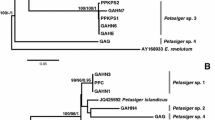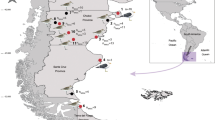Abstract
The small planorbid snail Gyraulus cf. laevis (Alder) from Lake Mývatn in Iceland was found to emit large-tailed cercariae with 19 collar spines, and three-spined sticklebacks Gasterosteus aculeatus L. were infected with metacercariae of a species of Petasiger Dietz, 1909. Comparative sequence analysis using ND1 mitochondrial DNA sequences revealed that the rediae and cercariae are conspecific with P. islandicus Kostadinova & Skirnisson, 2007, recently described from an isolated population of the horned grebe Podiceps auritus (L.) at the lake. The redia, cercaria and metacercaria are described and compared with related forms.




Similar content being viewed by others
References
Einarsson, Á., Stefánsdóttir, G., Jóhannesson, H., Ólafsson, J. S., Gíslason, G. M., Wakana, I., Gudbergsson, G., & Gardarsson, A. (2004). The ecology of Lake Mývatn and the River Laxá: variation in space and time. Aquatic Ecology, 38, 317–348.
Faltýnková, A., Gibson, D. I., & Kostadinova, A. (2008). A revision of Petasiger Dietz, 1909 (Digenea: Echinostomatidae) and a key to its species. Systematic Parasitology, 71, 1–40.
Fjeldså, J. (1973). Territory and the regulation of population density and recruitment in the horned grebe Podiceps auritus arcticus Boje, 1822. Videnskabelige Meddelelser frå Dansk Naturhistorisk Forening, 136, 117–189.
Hall, T. A. (1999). Bioedit: a user-friendly biological sequence editor and analysis program for Windows 95/98/NT. Nucleic Acids Symposium, Ser. 41, 95–98.
Karmanova, E. M. (1971). [The life cycle of Petasiger neocomense (Trematoda, Echinostomatidae).] Trudy Gel’minthologicheskoi Laboratorii, 21, 31–35. (In Russian).
Kostadinova, A., & Chipev, N. (1992). Experimental data on the life-cycle of Petasiger grandivesicularis Ishii, 1935 (Trematoda: Echinostomatidae). Systematic Parasitology, 23, 55–65.
Kostadinova, A., & Skirnisson, K. (2007). Petasiger islandicus n. sp. (Digenea: Echinostomatidae) in the horned grebe Podiceps auritus (L.) (Aves: Podicipedidae) from Iceland. Systematic Parasitology, 68, 217–223.
Kostadinova, A., Herniou, E. A., Barrett, J., & Littlewood, D. T. J. (2003). Phylogenetic relationships of Echinostoma Rudolphi, 1809 (Digenea: Echinostomatidae) and related genera re-assessed via DNA and morphological analyses. Systematic Parasitology, 54, 159–176.
Lockyer, A. E., Olson, P. D., & Littlewood, D. T. J. (2003). Utility of complete large and small subunit rRNA genes in resolving the phylogeny of the Neodermata (Platyhelminthes): implications and a review of the cercomer theory. Biological Journal of the Linnean Society (London), 78, 155–171.
Morgan, J. A. T., & Blair, D. (1998). Relative merits of nuclear ribosomal internal transcribed spacers and mitochondrial CO1 and ND1 genes for distinguishing among Echinostoma species (Trematoda). Parasitology, 116, 289–297.
Nasir, P. (1962). Two new species of giant-tailed echinostome cercariae from Planorbis carinatus (Mtill) [sic]. Transactions of the American Microscopical Society, 81, 132–137.
Tamura, K., Peterson, D., Peterson, N., Stecher, G., Nei, M., & Kumar, S. (2011). MEGA5: Molecular evolutionary genetics analysis using maximum likelihood, evolutionary distance, and maximum parsimony methods. Molecular Biology and Evolution, 28, 2731–2739.
Telford, M. J., Herniou, E. A., Russell, R. B., & Littlewood, D. T. J. (2000). Changes in mitochondrial genetic codes as phylogenetic characters: two examples from the flatworms. Proceedings of the National Academy of Sciences, 97, 11359–11364.
Tkach, V., & Pawlowski, J. (1999). Method for DNA isolation from ethanol-fixed specimens using guanidine thiocyanate. Acta Parasitologica, 44, 147–148.
Acknowledgements
We thank Drs David Gibson (Natural History Museum, London, UK) and Tomáš Scholz (Institute of Parasitology, ASCR, České Budějovice, Czech Republic) for their comments. This research was supported by the Czech Science Foundation (projects P505/10/1562 to AK and SG and 206/09/H026 to SG), the Grant Agency of the University of South Bohemia (GAJU) (project 04-135/2010/P to SG) and the Research Fund of the University of Iceland (to KS).
Author information
Authors and Affiliations
Corresponding author
Rights and permissions
About this article
Cite this article
Georgieva, S., Kostadinova, A. & Skirnisson, K. The life-cycle of Petasiger islandicus Kostadinova & Skirnisson, 2007 (Digenea: Echinostomatidae) elucidated with the aid of molecular data. Syst Parasitol 82, 177–183 (2012). https://doi.org/10.1007/s11230-012-9354-y
Received:
Accepted:
Published:
Issue Date:
DOI: https://doi.org/10.1007/s11230-012-9354-y




